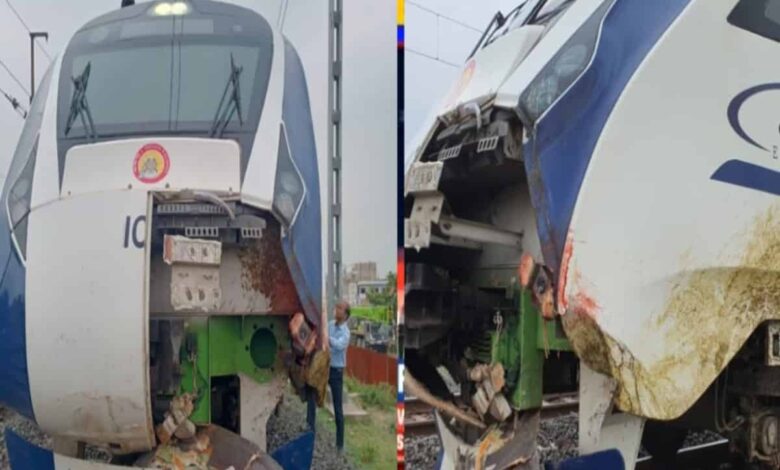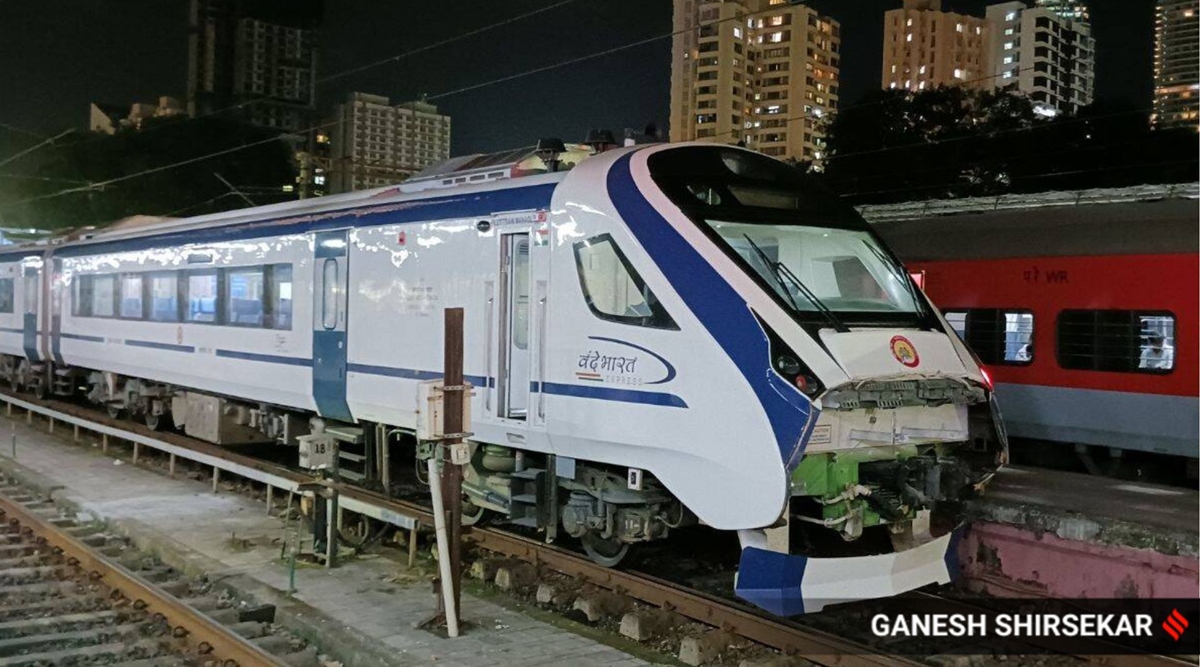Vande Bharat Express Hits Calf, Owner May Have To Pay Hefty Fine
When this accident happened, the train was traveling at a speed of 90 kilometers per hour. Just a week before this accident, on November 11, Prime Minister Narendra Modi flagged off South India's first train 'Vande Bharat Express'.

The Vande Bharat Express has again become a victim of an accident. In Arakkonam, Tamil Nadu, a calf got caught in the grip of a high-speed Vande Bharat, following which the train was damaged. While, the calf died in this incident. When this accident happened, the train was traveling at a speed of 90 kilometers per hour. Just a week before this accident, on November 11, Prime Minister, Narendra Modi flagged off South India’s first train ‘Vande Bharat Express’.
Considering the curves in the ghat section, the average speed has been fixed at 75 to 77 mph, which is the lowest in the five Vande Bharat Express trains introduced so far. After being the victim of an accident, the train had to be stopped for several minutes to determine the damage caused to it. After stopping for a while, the train departed for its destination Chennai. Please say this is the fifth Vande Bharat train-related incident since October.
The track searches for the owner of the calf Elumalai, Divisional, Public Relations Officer of Chennai Southern Railway said that the railway has planned to trace the calf’s owner. In addition, he may have to pay a heavy fine for releasing the calf and roaming the tracks so that others can learn from it. He said the move comes instead of damaging Vande Bharat trains after collision with animals.
Improvements In Vande Bharat Express
Safety and cost were the concerns of Indian Railways. Vande Bharat trains are air-conditioned coach service cars – a more premium version of the Shatabdi Express. The approved operating speed of the Vande Bharat is 160 km/h. The Vande Bharat Express train will serve healthy malt drinks for children. Passengers would be served Chikki sourced from local farmers.

In addition, IRCTC will match the catering services with Morning Tea, Breakfast, Hi-Tea, Lunch, and Dinner, following the Quality First motto. Indian Railways continued to reach 99 mph by the mid-2010s after the Gatimaan Express in 2016, the fastest train in operation to date. When the Indian Railways floated the tender in June 2015, they found none of the bids viable and decided to build it entirely in India.
In early 2017, the original engineless semi-express train with modern equipment was planned to run at 160 km/h (99 mph). Two new trainsets were announced for production at ICF and were named “Train-2018”, as the output of these semi-high-speed services was to be completed in 2018.
During the test runs, the train reached an operating speed of 180 km/h, and India conducted a test run at this speed for the first time with an LHB train in 2000 (according to the many LHB coach train speed certificates on the RDSO website), but the Vande Bharat Express has a higher acceleration.
The exterior of the Vande Bharat Express consists of an aerodynamic design, a taper at each end of the train designed to combat air resistance. It has a driver’s cabin at each end, allowing faster turnarounds at terminus stations. Two middle compartments are first-class compartments, each with a total of 52 seats; the rest are coach compartments with a total of 78 seats.

The undercarriage of the coach is 23 meters long, and the train frame is entirely made of stainless steel. Key imported components include bicycles and electronic components such as chips. Alternate buses are motorized to ensure even power distribution and help with faster acceleration and deceleration.
The aisles are interconnected and fully sealed to allow better mobility between cars and reduce noise. The train is equipped with a GPS-based passenger information system, bio-vacuum toilets, and swivel seats that can be oriented in the direction of travel (Executive Class only). Train 18 uses a regenerative braking system in Indian Railways, and ICF also planned to develop Train 20, another semi-high-speed train to replace the Rajdhani Express.
This new train was to have an aluminum body with sleeping cars.[33] Indian Railways planned to order 40 trainsets of Train 18 by 2022, which would include a modified cabin guard made of aluminum along with a lithium-ion battery.
The second version of ICF is set to build an upgraded version of these trains as part of the government’s plan to build 75 new trains by August 2023. Sudhanshu Mani, the former CEO of ICF, during whose tenure the Vande Bharat Express was introduced, said, “Now that ICF has developed four [Vande Bharat] trains and they understand the process, they can easily run three or up to four trains in a month, and around 40 by August 15 next year”.
In terms of safety features, the new rakes will be equipped with four emergency windows, emergency lights in all cars, in case of failure of the lighting system, fire survival cables inside the door perimeters, and emergency buttons will be increased to four per bus.
The new cars are to be equipped with a centralized monitoring system for all types of electricity, air conditioning, and other vital train systems. To solve the seat folding problems of the version, the new rakes will be equipped with a push-back system for smooth folding. The official added that the new cars will be equipped with a germ-free air-conditioning system and higher flood protection of the chassis equipment to ensure reliability during monsoons.
History Of Vande Bharat Express
After four years of planning, production, and testing, inducted on 15 February 2019, Train 18 was ready to start running from New Delhi to Varanasi. It was soon renamed ‘Vande Bharat Express’ by the railway minister. Following the success of the New Delhi–Varanasi route and later the New Delhi–Katra route, the Railway Board has approved the production of 45 new Vande Bharat trainsets by 2022. Despite this, the union minister decided to go ahead with the timetable and asked officials to build 10 trains by August 2022.
As of November 2021, the shells of at least five new sets were reported to be in the final stages of completion, with the electronics to be fitted over the next few months. The ICF hoped to launch at least one rake by March 2022, keeping the deadline in mind. In the Union Budget 2022, the government announced that it will produce 400 more Vande Bharat Express over the next three years. The railway will build a wall around the tracks Under the provisions of the Railways Act, of 1989, the owners of such animals can be punished under section 154.

Under section 154, intentionally or negligently endangering the safety of passengers during the journey of a train is punishable with imprisonment. Amid rising cases of animal collisions with Vande Bharat trains, Railway Minister Ashwini Vaishnav on Wednesday said the railways will build 1,000 km of masonry in the next six months in those parts where animal clashes and accidents have occurred.
edited and proofread by nikita sharma



